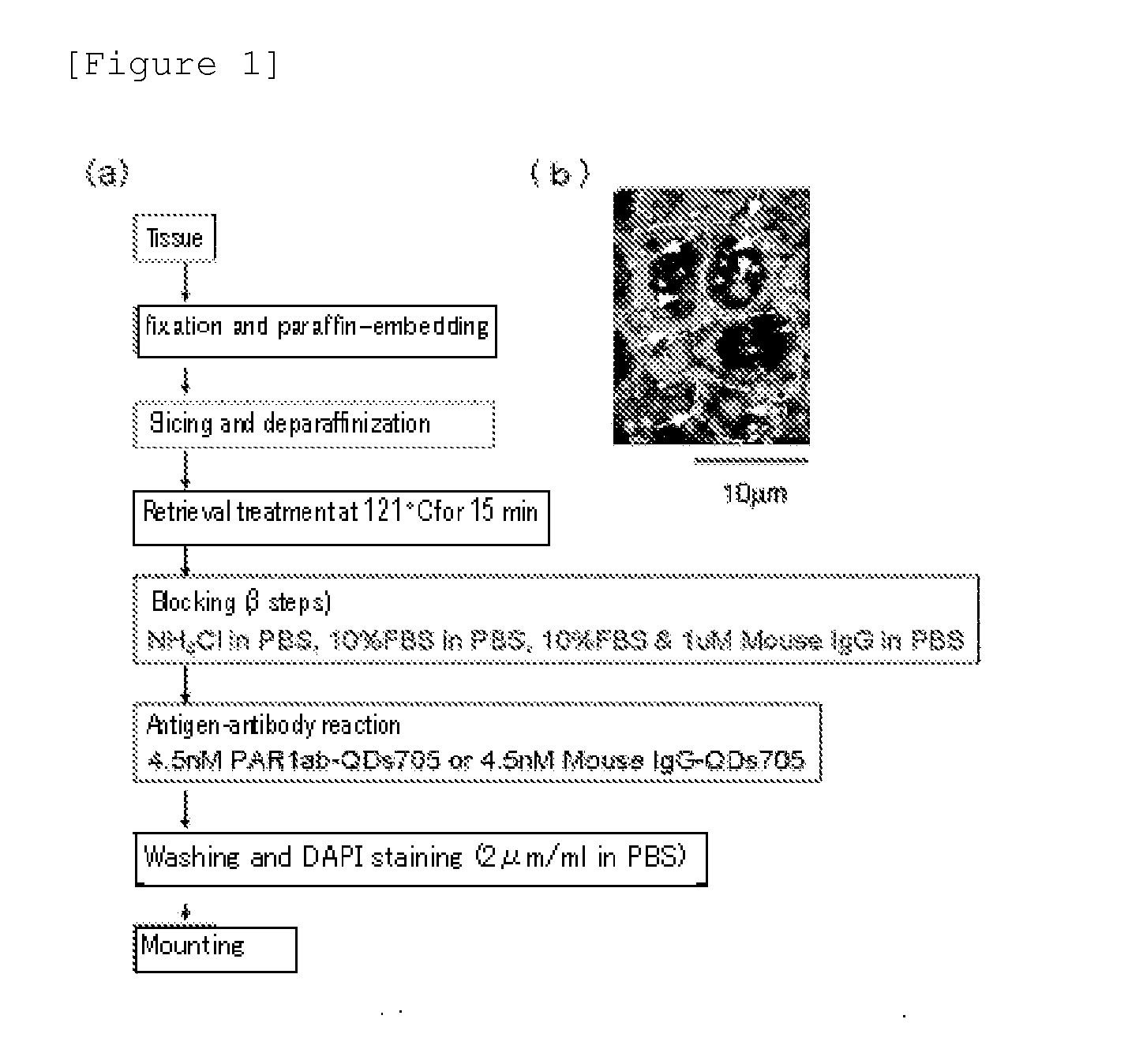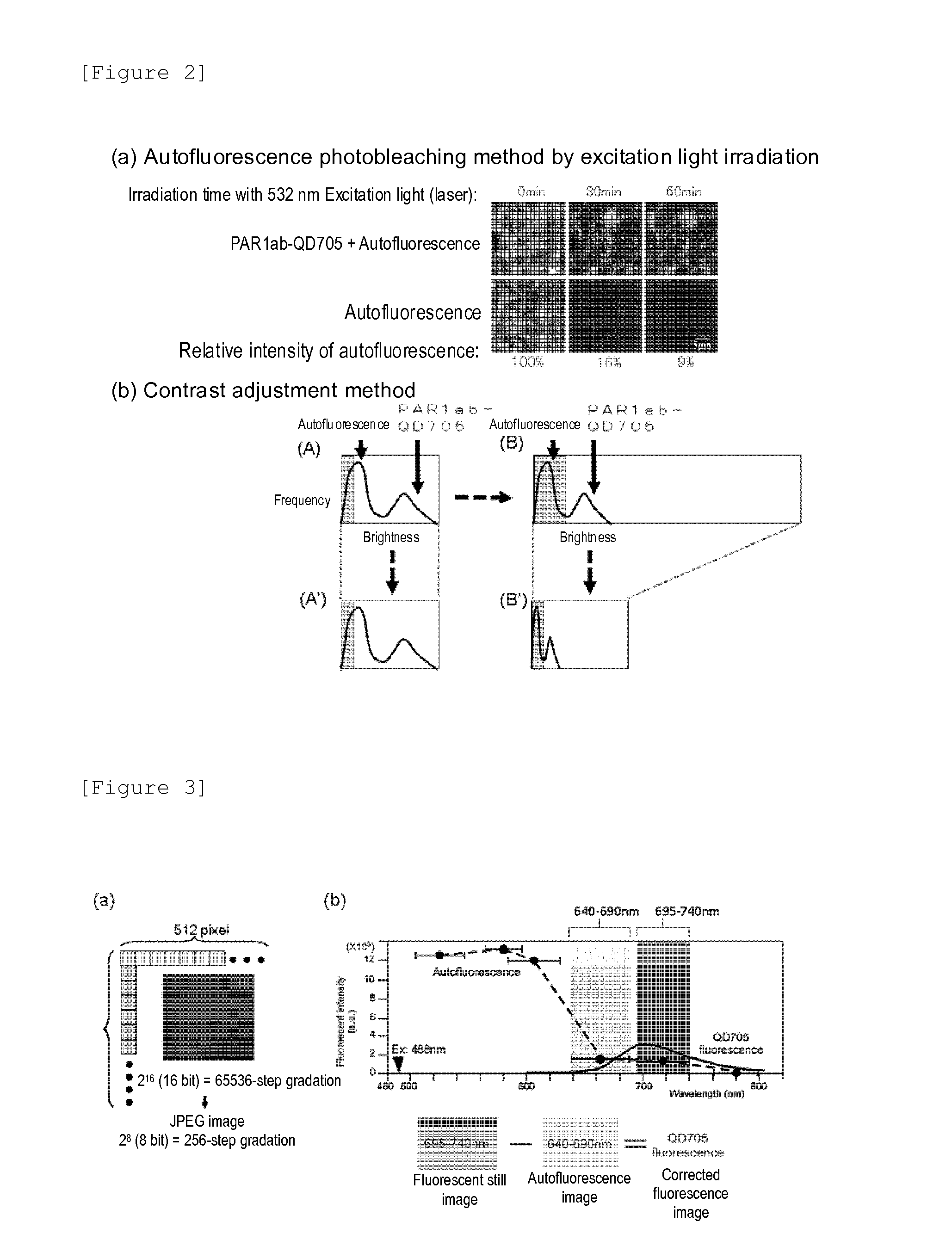Method for determining cancer onset or cancer onset risk
a cancer and risk technology, applied in the field of cancer onset or cancer onset risk, can solve the problems of difficult quantitative analysis of quantum dot fluorescent particles in biological tissues, inability to complete bleaching in many hours, and limited cultured cells, etc., and achieve the effect of high sensitivity
- Summary
- Abstract
- Description
- Claims
- Application Information
AI Technical Summary
Benefits of technology
Problems solved by technology
Method used
Image
Examples
example 1
[0044][Method for Preparing an Immunostained Tissue Sample]
[0045]To differentiate from HercepTest (detecting breast cancer tissues using HER2 antibody), all tissue samples used as the human breast cancer pathological tissue were HercepTest negative. On the other hand, there are cancer cases which develop with no connection to three major breast cancer growth-related factors (ER, PgR, HER2) and this “triple negative” breast cancers are generally considered to have poor prognosis and to be difficult to treat. Under the circumstances, the “triple negative” breast cancer tissue samples were also studied. More specifically, the total of 16 samples consisting of 4 samples (one of which is the “triple negatives” [since 20 to 25% of the recurrent patients are the “triple negatives”, 1 sample out of 4 samples was a randomly added “triple negative” sample]) of breast cancer tissues from recurrent patients (recurred within about 1 year and died within 4 years), 8 samples (including the above 1...
example 2
[0046][Problems in Fluorescent Immunohistostaining Method]
[0047]The immunostained tissue samples produced in the above Example 1 were irradiated with 488 nm excitation light using a combination device of a confocal unit (a product of Yokogawa Electric Corporation), a fluorescence microscope (a product of OLYMPUS CORPORATION) and Electron-Multiplier CCD (EM-CCD) Camera (Andor Co., Ltd.), and then a fluorescence image (fluorescent still image) of quantum dot fluorescent particle (detected using PAR1ab-QD705) was acquired using a 695 to 740 nm band pass filter. FIG. 1(b) shows the fluorescent still images of the tissue samples from recurrent breast cancer patients as an example, but the autofluorescence was so intense that the fluorescence of quantum dot fluorescent particle (detected using PAR1ab-QD705) was not identified on the first inspection. When the fluorescent brightnesses of autofluorescence and quantum dot fluorescent particles (detected using PAR1 antibody) were compared, on...
example 3
[0049][Production of Corrected Fluorescence Image from Which Autofluorescence is Eliminated]
[0050]A fluorescent still image with a zero (0) fluorescent intensity of the background autofluorescence need to be acquired. Then, the total fluorescence of fluorescent still image can be calculated as the fluorescence derived from quantum dot fluorescent particles. The contrast adjustment method of the above Example 2 uses the division of fluorescent intensity, thus failing to produce zero (0) by the division, and accordingly an image processing method which uses the subtraction capable of producing zero (0) is required. Under the circumstances, the following method is proposed as the image processing method for eliminating the autofluorescence of a fluorescent still image. In the method, first, a breast cancer tissue sample immunostained with quantum dot fluorescent particles is irradiated with excitation light (laser) having an excitation wavelength of 488 nm, an fluorescence image of qua...
PUM
 Login to View More
Login to View More Abstract
Description
Claims
Application Information
 Login to View More
Login to View More - R&D
- Intellectual Property
- Life Sciences
- Materials
- Tech Scout
- Unparalleled Data Quality
- Higher Quality Content
- 60% Fewer Hallucinations
Browse by: Latest US Patents, China's latest patents, Technical Efficacy Thesaurus, Application Domain, Technology Topic, Popular Technical Reports.
© 2025 PatSnap. All rights reserved.Legal|Privacy policy|Modern Slavery Act Transparency Statement|Sitemap|About US| Contact US: help@patsnap.com



